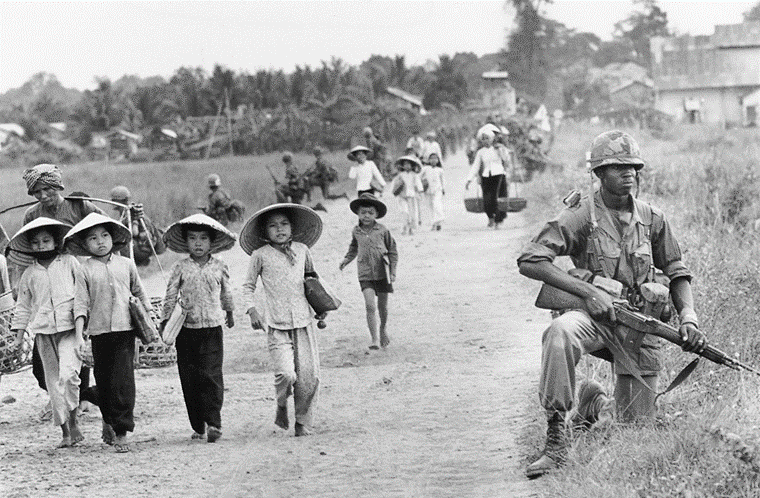 U.S. counter insurgency operations in Iraq and Afghanistan have failed to utilize the most powerful tool at their disposal: populations. In fact, current counter insurgency strategies alienate U.S. forces from the population and inadvertently drive communities and insurgents closer together. Current campaigns employ short-term strategies that fail to create enduring security environments through (a) separating insurgents from the population and (b) delivering utility to populations. But most importantly, current counter insurgency operations do not provide solutions for the long-term problems that insurgencies create.
U.S. counter insurgency operations in Iraq and Afghanistan have failed to utilize the most powerful tool at their disposal: populations. In fact, current counter insurgency strategies alienate U.S. forces from the population and inadvertently drive communities and insurgents closer together. Current campaigns employ short-term strategies that fail to create enduring security environments through (a) separating insurgents from the population and (b) delivering utility to populations. But most importantly, current counter insurgency operations do not provide solutions for the long-term problems that insurgencies create.
“A state rarely rises up without the fault of its governors.” Seek the people’s “heart and love.” – Theorist Santa Cruz de Marcenado
Contemporary U.S. counter insurgency campaigns are ineffective. At the strategic level, they employ top-down approaches that invest vast amounts of resources to strengthen illegitimate government institutions. Unfortunately, these governments often fuel the drivers of the insurgency (e.g. Afghanistan and Iraq). Simultaneously, insurgents establish legitimacy with populations by providing goods and services, rule of law, and governance when the national government does not. Moreover, insurgents reinforce their activities through sophisticated, targeted narratives that resonate with the population.
At the tactical and operational levels, counter insurgencies rely almost exclusively on special operations forces, close air support, and drone strikes that fail to address the drivers of instability. They are dependent on indigenous security forces to safeguard the population and focus on Western doctrine and “man, train, and equip” initiatives to shape the future security landscape. Most importantly, U.S. forces are subject to strict rules of engagement, which prevent them from interacting with the population.
“Unless the hearts and minds of the public can be separated from the insurgency, the occupation is doomed to fail.” – Military theorist B. H. Liddell Hart
Insurgencies are the organized use of subversion and violence to seize, nullify, or challenge political control of a region. In order to defeat insurgents, counter insurgencies must combine conventional military operations, propaganda, and psy-ops, designed around two basic concepts: (1) insurgencies are the result of a population’s grievances, perceived or real, toward the government and (2) the key to victory is to win the support of the population.
Counter insurgencies are violent, protracted campaigns. They are military and political activities designed to prevent insurgents from seizing control of the government. There are over 60 active insurgencies around the world, many of which do not make international headlines, like the Chittagong Hill Track in India, East Turkestan Islamic Movement (ETIM) in China, and National Liberation Army (ELN) in Colombia. They are responsible for the displacement of millions and deaths of hundreds of thousands of combatants and non-combatants. In Syria alone, over 450,000 lives have been lost in the past five years.
Counter insurgencies are very effective when done correctly. The British campaign against the Malayan National Liberation Army (MNLA) from 1948 until 1960 provides a successful example. The British Army’s Director of Operations in Malaya developed a strategy to cut insurgents from supporters within the population. Conventional British army units implemented a “hearts and minds campaign” by providing medical care and food to Malays and indigenous tribes. At the same time, they pressured the MNLA by patrolling the jungle. The MNLA guerrillas were driven deep into the jungle and denied resources, which removed their control and influence over Malayan society.
“The key terrain is the human terrain…victory is the permanent isolation of the insurgent from the population.” – Counter insurgency theorist David Galula
The act of renaming insurgencies fourth generation warfare, asymmetric warfare, low intensity conflicts, or grey zones in the hopes of changing the outcomes is futile. Allowing U.S. troops to accompany Afghan units into the field is not a solution, nor is restructuring military commands to make SOCOM the functional lead in the new “Campaign Plan for Countering Trans-Regional Terrorist Organizations.” This is merely putting lipstick on a pig.
While U.S. counter insurgency efforts continue to fail, the number and magnitude of insurgencies across the globe continues to increase. Grievances against governments, perceived or real, escalate due to competition for resources, pandemics, globalization, climate changes and the proliferation and access to communications technologies. The U.S. will continue to be drawn into brewing insurgencies as grievances turn into violence and threats to national interests. Unlike political cycles, insurgencies often last for decades. The key to a successful counter insurgency operation lies not with kill-capture, drone strikes or misplaced Western philosophies, but with the people.
Watch our video series on Counter Insurgencies on YouTube.

